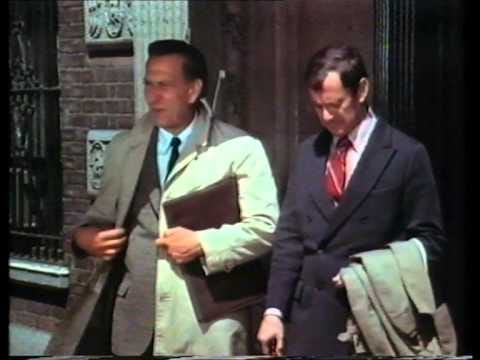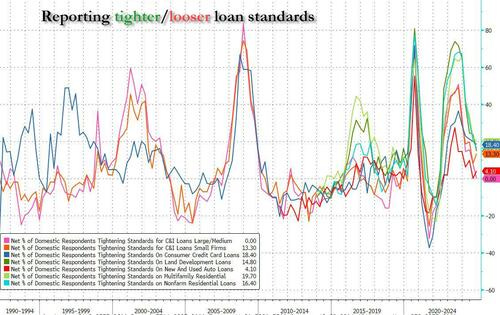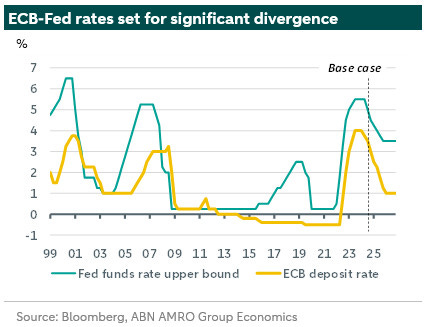while WE slept: USTs are 'incrementally firmer' ahead of CPI; #Got$TMF?
Good morning … Happy Felix Unger Day …
… ahead of this mornings CPI — expected to be HOT, see ING and others below, for somewhat more — and in addition TO what techAmentalists had to offer yesterday — signs of uptrend exhaustion, I’ll lead with a quick, rude and crude update of 2yy …
2yy DAILY: 4.25% is approx where (green)TLINE resistance hits …
… as momentum remains overSOLD ahead of / in to this mornings CPI breach we go …
… and with 2s in mind, a quick recap of a couple drivers of price action yesterday (reminder: Small Caps Slayed As Yields, Crypto, & The Dollar Soar) …
ZH: NY Fed Survey Finds Broad Improvement In Economic Sentiment As Inflation Expectations Slide
ZH: Banks Report Tighter Standards, Weaker Loan Demand But Some Improvement As Financial Conditions Continue To Ease
…In addition, banks reported basically unchanged lending standards and demand for home equity lines of credit (HELOCs). Moreover, standards reportedly tightened for credit card loans and remained basically unchanged for auto and other consumer loans, while demand weakened for auto and other consumer loans and remained basically unchanged for credit card loans.
In short, less demand, tighter supply.
…Putting it all together, banks anticipate further tightening lending standards across most categories, even as consumer fight with each other for what little loan availability exists while scrambling to load up their credit cards with as much debt as possible before the next bust.
CalculatedRISK: Fed Q3 SLOOS Survey: Banks reported Mostly Tighter Standards and Weaker Demand for All Loan Types
AND ‘nuff from me with little else to add ahead of CPI, here is a snapshot OF USTs as of 700a:
… and for some MORE of the news you might be able to use…
IGMs Press Picks: November 13 2024
NEWSQUAWK: US Market Open: Dollar & USTs flat ahead of US CPI and a slew of Fed speakers … USTs are incrementally firmer and ultimately in stasis ahead of US CPI; Gilts continued to underperform…USTs are incrementally firmer. Specifics so far have been light with USTs coming under modest pressure overnight, to a 109-9 trough, on a soft 30yr JGB tap and above-forecast Japanese corporate good prices. Docket ahead is headline by CPI, after which we hear from numerous Fed speakers. USTs at a 109-17+ peak, resistance some way off at yesterday’s 110-04+ best before 110-07+ from Monday.
Reuters Morning Bid: All eyes on CPI
Finviz (for everything else I might have overlooked …)
Moving from some of the news to some of THE VIEWS you might be able to use… here’s SOME of what Global Wall St is sayin’ …
First UP with idea that elections have consequences, in mind …
ABNAmro: New forecasts following US election
Global Macro: Growth & inflation tariff impact to drive Fed-ECB divergence – We are updating our growth and inflation forecasts in light of the US election result last week. While the election count has not fully concluded, the Republican party looks on course to win a House majority, to accompany the presidency and the Senate majority. By controlling all three branches of government, president Trump therefore has significant power to enact his policy platform. It remains highly uncertain how far Trump will go with his tariff plans, and so there is naturally high uncertainty around our new forecasts. But broadly speaking, the main outcomes of the plans are likely to be: 1) much lower eurozone growth and inflation than in our prior baseline, 2) significantly higher US inflation, and (ultimately) lower growth. This combination is likely to mean fewer interest rate cuts by the Fed, but more rate cuts by the ECB; this will in turn continue to weigh on the euro, which has already weakened significantly in recent weeks as markets moved to price in a Trump victory.
Below is a high-level summary of our new forecasts – next week Friday, we will publish our Global Outlook 2025, which will go more in-depth.
Our new base case
We assume a gradual stepping up of US import tariffs starting in Q2-25 (China, to 60%) and Q3-25 (rest of world, to rise by 5pp on average, on top of existing tariff rates). This is likely to drive a renewed divergence in US & eurozone growth, leading to extended rate cuts by the ECB to prop-up eurozone growth, but slower Fed rate cuts in response to upward inflationary pressure in the US. Before that time, activity in both eurozone and US growth may see a temporary lift; in the eurozone, from a front-loading of exports to the US to get ahead of the tariff rises, and in the US, from tax cuts and post-election euphoria (headline GDP growth is somewhat weaker due to higher imports, but domestic demand is strong).Later in 2025 and into 2026, global growth will likely then face headwinds from the hit to global trade from tariffs, though we expect only targeted retaliation from the US’s trade partners as opposed to blanket tariffs. As such, outside the US, we expect inflationary pressures to remain contained, particularly against the backdrop of global excess supply, which continues to keep a lid on goods inflation…
Trump tariffs lead to significant eurozone growth & inflation hit…
…while pushing US inflation higher, and growth ultimately lower
… Next up, this shop from Germany who put out long term asset return study (yest) offering some insight as to rise in rates yest and a note on pricing of increased supply in RATES …
DB: Early Morning Reid
…Talking of debt, Treasury yields surged yesterday as the market continues to try to come to terms with the implications of the US election result that was emerging exactly a week ago as I type. This is all ahead of today's US CPI which will be a key factor in the Fed’s decision next month. That’s particularly important this time around, as there’s been speculation the Fed might skip this meeting and not cut at all, with futures only pricing in a 59% chance of another cut next month. However Minneapolis Fed’s Kashkari, one of the more hawkish FOMC voices, did suggest a still reasonably high bar for the Fed to pause next month, saying that “there’d have to be a surprise on the inflation front to change the outlook so dramatically”.
Nevertheless, the December 2025 Fed futures contract was up another +6.0bps to 3.88% yesterday. In turn, that led to a clear run-up in Treasury yields, and the 2yr yield (+8.7bps) reached its highest since July at 4.34%, whilst the 10yr yield was up +12.4bps to 4.44%. That repricing also led to a fresh move up for the dollar index (+0.46%), which closed at its highest level since June. But that meant it was a different story elsewhere, with the Euro down to a one-year low of $1.0607, and sterling fell to a 3-month low of $1.2733…
DB: Divergent fiscal pricing
There are two key places in US rates to look for the effects of UST supply.
The first is term premia, the excess yield on term rates over the expected average short-rate path. Private investors should require higher premia in order to absorb additional supply and aggregate duration risk. The second is swap spreads, as additional supply of cash bonds should also lead them to cheapen relative to swaps.
Interestingly, these two measures have recently diverged sharply. As shown in the chart, over the past few years up to this spring, our 5s10s swaps TP measure and 10y swap spreads were closely correlated, with swap spreads tending to narrow as term premia rose and vice versa. That relationship has broken down.
While a number of factors are likely at play (and it's important to keep in mind that these measures don't always track each other as closely as in the earlier period shown), we interpret the recent dynamics as reflecting differential pricing of the fiscal outlook in swap spreads and TP. One factor that may have kept term premia in check is the Fed outlook, as policy rates above neutral put flattening pressure on the curve and may constrain pricing of TP (which is a steepening in the forward curve).
Looking ahead we expect some convergence in these measures. As shown by the dashed line, based on the current 10y spread and its relationship with TP up to this spring, we'd expect 5s10s swaps TP to be a bit above 100bp (vs. current of 79bp). That implied value is in line with our tentative expectation for TP in light of the Trump sweep. Going the other way, given current swaps TP, the recent relationship would put the 10y swap spread at around -35bp (vs. current of -48bp).
… ahead of CPI, setting the bar of expectations low …
ING: Rates Spark: Another hot US CPI expected
Markets continue to price in fewer Fed cuts and a hot CPI figure could continue in this direction. Euro rates show an opposite trend as weaker data keeps showing up and could thus diverge more from the US. More clarity on the German elections can help stabilise the Bund ASW spread
… #GotEARL?
MS: The Oil Manual: The 2025 Surplus Remains Unresolved
Uncertainties around the Middle East and US presidential election are past their peaks for now, which leaves the outlook dominated by the expected surplus in 2025. As demand continues to come in below expectations, this surplus remains on the horizon. We lower price forecasts modestly to reflect this.
Key takeaways
We lower our full-year demand forecast from 0.95 to 0.8 mb/d for 2024, and from 1.1 to 0.95 mb/d for 2025. In total, our 2025 demand estimate falls 0.4 mb/d.
Still, we also lower our OPEC supply estimate by a similar 0.4 mb/d in 2025, based on the one-month delay, better compliance in Iraq, and lower exports from Iran.
In turn, this leaves our estimate for a 1.3 mb/d surplus in 2025 intact. Whist this surplus remains on the horizon, risks to prices probably remain skewed lower.
Looking ahead to the 1 Dec OPEC meeting, our base-case expectation is that after the recent adjustment, the current OPEC+ agreement now remains unchanged.
The outcome of the US election can impact oil prices considerably over time, but offsetting effects make the direction hard to call, probably for a while.
… answering the question we all have on our minds …
UBS: The future of inflation and interest rates
We get US consumer price inflation data today. In one sense, the numbers are curiously unimportant. There are potentially competing forces at work on future US inflation. The fantasy owners’ equivalent rent measure should slow, but does not change anyone’s inflation reality. Oil prices may be lower, depending on US supply and Middle Eastern policies. Larger fiscal deficits, labor deportations, and consumer taxes via tariffs would all add to inflation pressures.
While energy prices may add to the headline, the underlying disinflation pressures (deflation pressures in the case of durable goods) should be evident in the detail. That should allow the Federal Reserve to cut rates in December, to try and keep real rates stable.
European Central Bank (ECB) speakers have tended to confirm market expectations for a December rate cut in Europe. Trade tensions have received some attention (retaliatory tariffs would add to Euro inflation, but would have a narrower effect).
US President-elect Trump has announced some cabinet nominees, but not the Treasury Secretary markets are focused on. The backgrounds of some nominees differ from similar appointments eight years ago, which might warn against extrapolating from the earlier Trump term. Two businesspeople have been nominated to run a government efficiency department.
… OK, then … absolutely NO answers there …
… small biz, the engine of growth here in ‘Merica …
Wells Fargo: Small Businesses Gain Optimism in October
Fed Cuts and Election Hopes Spark Improvement, Countering Current ChallengesSummary
Looking Past the Headline Jump, Signs of Weakness Persist
The start of the Fed's easing cycle appeared to give small business owners a dose of optimism in October, while expectations surrounding November's election also likely played a role. The NFIB Small Business Optimism Index rose 2.2 points to 93.7, tied with July for the biggest over-the-month jump this year. Most components improved over the month, the most substantial being a seven-point surge in expectations for better business conditions. Yet, looking past the headline improvement in optimism, the underlying details suggest that small businesses are standing on shaky economic ground. Small business sales plummeted to its weakest reading since July 2020 while labor demand continued to deteriorate. Although hurricanes Helene and Milton likely explain softer hiring in October, plans for future hiring also continued to stall, remaining essentially unchanged since May. On the upside, inflation pressures continued to slowly ease, and the Fed’s first rate cut in September seems to already be improving borrowing conditions for small businesses.Source: NFIB and Wells Fargo Economics
… and finally, this one seems to be attempting to express a political view rather than market related apolitical one … oh well
Yardeni: From Election Uncertainty To Policy Uncertainty
The NFIB survey of small business owners was released today showing a record high in their uncertainty index during October (chart). That's not surprising since the polls showed that the presidential race was too close to call, raising the prospect of a contested election. The same happened prior to the previous two elections. The uncertainty index will undoubtedly fall when November's survey is released. However, it may stay relatively elevated because Donald Trump's victory now raises lots of uncertainties about his policies. His clean sweep doesn't leave much doubt that he will get the legislation he wants out of Congress.
The stock market rallied to new record highs after Trump won because stock investors accentuated the positives of tax cuts and deregulation. They might also be expecting speedier resolutions of current geopolitical crises, which explains why the price of gold has been weak. Before the election, we expected the Nasdaq to rise to 20,000 by mid-2025. It may get there by yearend (chart). On Sunday, we raised our S&P 500 targets to 6100 by the end of this year and 7000 by the end of next year…
… And from Global Wall Street inbox TO the WWW …
Positions matter and you know I think that. You ALSO know I believe there aren’t many out there avail to US who write ‘bout it as well as Ed Bolingbroke and so …
Bloomberg: Traders Ramp Up Bets on a Treasury Selloff After Trump’s Win
Treasury futures’ open interest rises as yields have climbed
New bearish positions face inflation data test on Wednesday
… Investors have been adding to short bets on US bonds since the election, and in advance of a report Wednesday that is expected to show inflation slightly picking up in October. Open interest, an indication of futures traders’ positioning, rose for a fifth-consecutive session in the two-year contract, preliminary data released on Wednesday show.
“It’s plausibly in the near term yields can rise to 4.6%,” said Henry Allen, a macro strategist at Deutsche Bank AG, in a Bloomberg TV interview. “There’s definitely upside risks on that because you’ve got the tariffs coming in, you’ve got fiscal stimulus coming down the tracks.”
… next up, like him or NOT, a decent WEEKLY visual of 10yy …
Crescat (via LinkedIN)
This chart is concerning.
The 10-year yields seem poised for another breakout after what appeared to be over a year of consolidation in my view.
As inflation expectations continue to rise, it's worth noting that more than a third of US debt is set to mature within the next three years.
… and for some out there trading ETFs that represent bonds when bonds were closed (Monday), things like this one sorta stand out …
The Daily Shot Brief – November 12th, 2024
Rates: The 3x leveraged long-term Treasury ETF is experiencing massive inflows, indicating that some investors believe Treasury yields are peaking.
… #GotTMF?
AND … THAT is all for now. Off to the day job…










